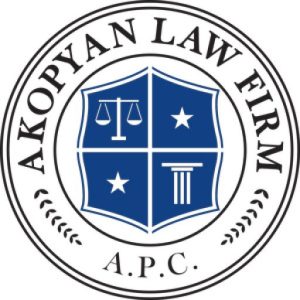Calimesa Employment Attorneys
The trial attorneys of the Akopyan Law Firm A.P.C. stand ready to fight for the rights of the residents of Calimesa, regardless of whether they are employees or employers. If your cause is just and involves employment law, give us a call to see how we can help.
 Calimesa, California
Calimesa, California
Calimesa is city located in Riverside County. Calimesa covers only fifteen square miles and is home to roughly 10,000 residents. Calimesa lies within zip code 92320. Historically, Calimesa began as a small rural town with mostly single-family homes and ranches. With completion of U.S. Route 99 (modern day I-10), businesses opened and Calimesa began to take on a separate identity from the larger neighboring town of Yucaipa. In June 1929, nearly 100 residents attended a meeting and decided to apply for their own post office and to start a “name contest” in which the winner was paid $10. Calimesa was chosen from 107 names submitted, and is said to come from “cali” (referring to California) and “mesa” from the Spanish word meaning “table” or “table-lands.” The first post office was the grocery store at Calimesa Boulevard and Avenue K. The City of Calimesa was incorporated on December 1, 1990, soon after the incorporation of its northern neighbor, the City of Yucaipa. Prior to its incorporation, the City of Calimesa existed as an unincorporated census designated town that straddled the Riverside–San Bernardino County line at the location where Interstate 10 climbs the San Gorgonio Pass going eastward from Redlands, California.
The Best Employment Lawyer in Calimesa
Searching online for an “employment lawyer in Calimesa” or a “wrongful termination attorney in Calimesa” can indeed yield a plethora of paid advertisements from attorneys hailing from various locations. This abundance of choices can make the task of identifying the right attorney, one with the necessary expertise and experience, quite challenging when the primary basis for selection is an internet advertisement. It can be particularly hard for individuals to gauge whether a particular attorney possesses the in-depth knowledge required for this field and a track record of effectively handling employment trials and litigation when they have nothing more than an advertisement to rely on.
At the Akopyan Law Firm, A.P.C., every attorney brings nearly two decades of experience to the table. Our legal team has consistently delivered successful outcomes for both employees and employers, establishing a solid track record. Our firm’s philosophy prioritizes quality over quantity, and we dedicate ourselves to providing top-notch legal representation. With offices located just minutes away from Calimesa, we are poised to offer residents high-caliber legal services.
In addition to our proximity to Calimesa, our firm has offices in Los Angeles, Bakersfield, Oxnard, Temecula, Rancho Cucamonga, Costa Mesa, Culver City, and San Diego, making us easily accessible to clients in the region. Our employment lawyers are prepared to deliver world-class services and exceptional representation to the residents of Calimesa. We understand the importance of having a seasoned and trustworthy attorney by your side, especially in employment-related matters, and we are ready to stand with you.
We Can Help Calimesa Residents With:
Featured Article:
Denied Reasonable Accommodations for Your Back Injury? What California Law Requires from Employers
📌 Key Takeaways When your back injury limits your work, knowing California’s accommodation rules can be the key to protecting your livelihood. FEHA Provides Stronger Protections: California’s Fair Employment and Housing Act offers broader disability accommodation rights than federal law, especially for employees with back injuries. The Interactive Process is Mandatory: Employers must engage in a good-faith, two-way discussion to identify effective accommodations that allow you to perform essential job functions. Accommodations Can Be Varied: Options may include, but are not limited to, ergonomic equipment, modified schedules, or workplace adjustments tailored to your functional limitations. Employer Duties Have Limits: Requests may be declined if they impose undue hardship, remove essential job functions, or create a direct safety threat that cannot be mitigated. Information Exchange is Critical: Clear communication and appropriate documentation are essential to ensuring employers understand and respond to accommodation needs. Understanding these principles empowers you to navigate workplace challenges with confidence while keeping your career on track. California Statutory Framework Overview Under California law, the Fair Employment and Housing Act (FEHA) generally requires employers to provide reasonable accommodations to qualified employees with disabilities, which may include back injuries. FEHA’s protections are often broader than those found in the federal Americans with Disabilities Act (ADA), meaning that an employee in California may have additional rights not available under federal law. A physical condition that limits major life activities—such as lifting, bending, or standing for extended periods—can meet the statutory definition of a disability. These legal frameworks aim to protect employees across various industries, including physically demanding fields such as construction, healthcare, warehouse work, and manufacturing. Employer Obligation Concepts California law requires employers to engage in an interactive process with employees who request accommodations due to a disability. This process is intended to be a collaborative, good-faith dialogue focused on identifying and implementing effective workplace adjustments. Potential accommodations may include changes to the work environment, adjustments to job duties, or modifications to work schedules. The goal is to enable the employee to perform the essential functions of the position while ensuring that the employer’s operations can continue effectively. Back Injury Accommodation Categories For employees with back injuries, reasonable accommodations may include, but are not limited to: Workplace modifications such as ergonomic chairs, adjustable desks, or reconfigured workstations. Schedule adjustments like flexible start times, split shifts, or reduced work hours. Supportive equipment including lumbar cushions, standing desks, or specialized lifting aids. These accommodations are designed to help the employee carry out essential job functions without causing undue hardship to the employer. Statutory Limitation Concepts FEHA recognizes that an employer’s obligation to accommodate is not without limits. Three primary legal concepts define these boundaries: Undue hardship – An accommodation may not be required if it would cause significant difficulty or expense for the employer. Essential functions – These are the fundamental job duties that an employee must be able to perform, with or without accommodation. Direct threat – An employer may not be required to implement an accommodation if it would... Read more









Millions of Dollars Recovered For Our Clients
Check Out Our Case Results



